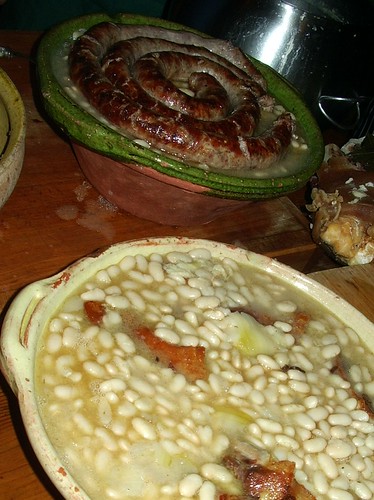I never went to camp. So now and again that childhood desire arises and I create the ephemeral camp of my dreams. My ideas of it are all screwed up with Disney movies and girl scout meetings. But I’ve lived in a pup tent, can easily start a fire and make a mean s’more- (cultural translation here ) Or cassoulet.
For years, I have been referring to My Camont as Camp France, a sort of license to have fun in a somewhat unrealistic setting (silly big barge, small rowboat, princess tower house, big kitchen… in France.) As the cooking classes and gastronomic tours became the ‘day job’,
With a little encouragement from afar and a handful of French regional cookbooks, I set the standard under some protest from a few more vocal members of the gathering: no tomato, no breadcrumbs and no lamb (there’s nary a sheep in sight in this particular part of
The resulting flavors were all I had hoped for- creamy, deep, crusty and soul satisfying. Hearty, yes, but also delicate in texture with sweet beanness and bursting with small morsels of savory salty and cured meats.
With 10 cooks, several bottles of wine and a dozen different pots to choose from …let’s just say it was fun, if a little chaotic. Personally, I like a little chaos in the kitchen so I felt right in my own home. With the help of a good crew of galley ghillies and able scribe Nicky noting it down, we did manage to weigh, measure, and time the official
Cassoulet Recipe
from Kate Hill’s French Kitchen Adventures- "Camp Cassoulet"
Amount: This makes a large cassoulet that fills a 4-liter cassole and feeds 8 people easily. For a visual reference for cassole look here, here, and here.
Step 1: the beans
Ingredients:
- beans -1 kg dried beans (tarbais, coco, lingots, or other plump thin skinned white bean (for dried beans- soak over night or cover with water, bring to boil and let sit one hour.)
- 1 onion- peeled
- 2 cloves
- 2 garlic cloves
- Thick slice of ventrèche (pancetta), salt pork, bacon or ham ends.
- Ham bone or hock
- Fresh pork rind- about a 4 by 12 inch strip or about 100gr, rolled and tied with a string
- Bouquet garni- bay, thyme and parsley stems.
Step 2: the meat- prepare while the beans are cooking.
Ingredients:
- Duck- confit de canard- one/half leg per person (note: after slipping off most of the softened congealed fat from the surface of the duck legs, we trimmed any excess skin so as to leave just a covering to protect the meat. We jointed the thigh from the drumstick and then teased the thigh bone out resulting in a neat little package of confit meat that is easier to cut in the plate.)
- Saucisse de Toulouse- about 500 grams or about 15 cm/6 inches per person. This is a fresh pork sausage made from primarily the shoulder meat and seasoned with salt and pepper. Nothing else.
- Saucisse de Couenne- I love how these succulent sausages made with lean pork meat and the soft rind taste. They sort of explode with flavour in the cassoulet.
Step 3: to assemble the cassoulet
The very bottom of the cassole or casserole should be lined with the cooked couenne (pork rind), fat side down. The traditional cassole bottom is just half of the diameter as the top, making a deep slant-sided glazed terracotta pot (see pictures). Remove the bouquet garni, ham bones and onion from the beans and reserve the liquid. The cassole is then layered with the beans, confits and pieces of
Step 4- To cook the cassoulet
Slip the cassole into a very hot oven (around 450’ F/ 275’C); turn down the oven after 30 minutes to medium heat- 350' F/175'C and let the cassoulet bake slowly. The wood oven did this by itself as the coals cooled down ; the fireplace cassoulet was covered with aluminium foil bubbled and cooked at one side at a time so we turned it every time we could hear it cooking away! This was the one that had the sausage spiral on top. The cassoulet in the electric oven was nicely browned in about 1-1/2 hours; we ‘broke’ the crust by pushing into down into the juices two or three more times. A wonderful crust forms during cooking so there is no need for a sprinkle of breadcrumbs* as the beans and sauce do this by themselves. None of the cassoulets were fatty and the one made with tarbais beans had the best texture; the beans were large, firm and creamy and there was ample 'sauce' to make the dish a little looser than the others. All cassoulets were nicely done in about 2 hours. We started preparing the cassoulet at around 3 pm and we’re sitting at the table by eight pm. This could be done in advance- all or in part by cooking the beans, and or assembling before baking.
Step 5: to serve
Pour a glass of hearty red wine like a Madiran, Cahors or Zinfandel, break the crust on top, ladle the steaming cassoulet into dishes and prepare to be very full and very warm as stories are told around the kitchen table well into the night!
cassoulet photos by: Jennifer Greco
* breadcrumbs- we nearly came to blows over this one. Although I do love a thick crumbling gratinée, I would reserve the use of breadcrumbs for non-starchy dishes and let the beans do the work here.










3 comments:
Thank god someone was organized enough to write everything down while the chaotic cooking and picture taking was going on!
I was thinking as I drove home that I left Camont without getting the recipe!
Kate, your enthusiasm is contagious. I have always wanted to learn to make an authentic cassoulet, and am now convinced it has to be done IN France. It is next to impossible to replicate that dish outside of the country. I love that you are exacting in your use of local ingredients and sticking to tradition! (I am that way with my Italian food.) I hope to be a participant in Camp Cassoulet one of these years.
Jeni
Jeni-
Making this dish is very possible outside France - try using chicken thighs if you don't want to order the duck. There is a recipe on this blog for the the Saucisse de Toulouse and you can substitute other meats (listed) for the Saucisse de Couenne. If you aren't in France it just takes more effort to find the stuff you need, but hopefully that is changing...
Post a Comment